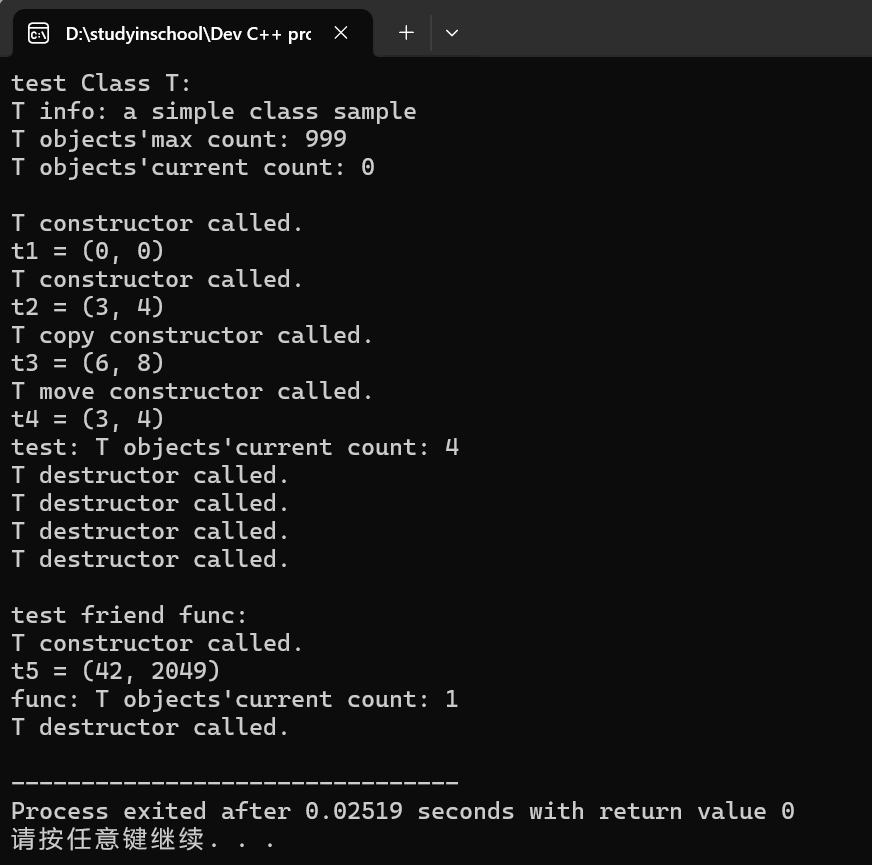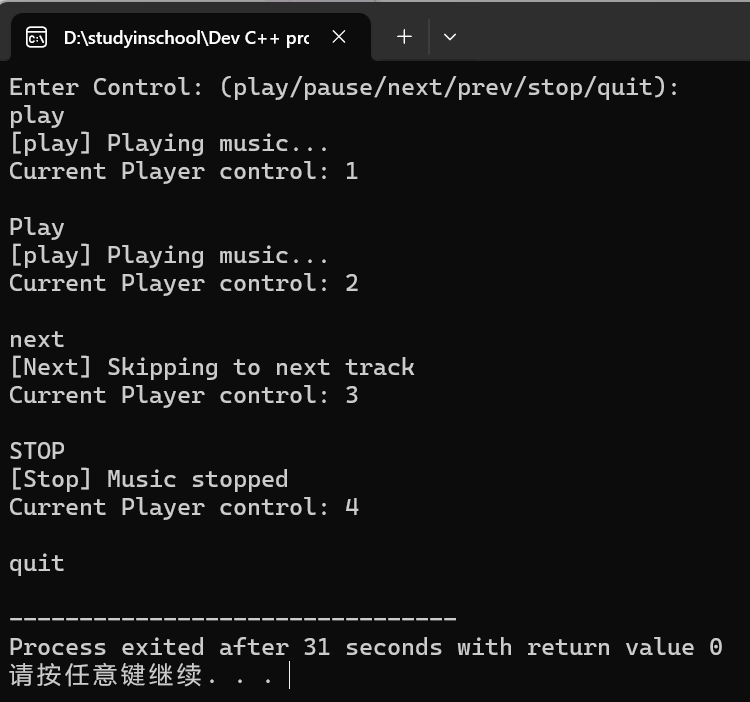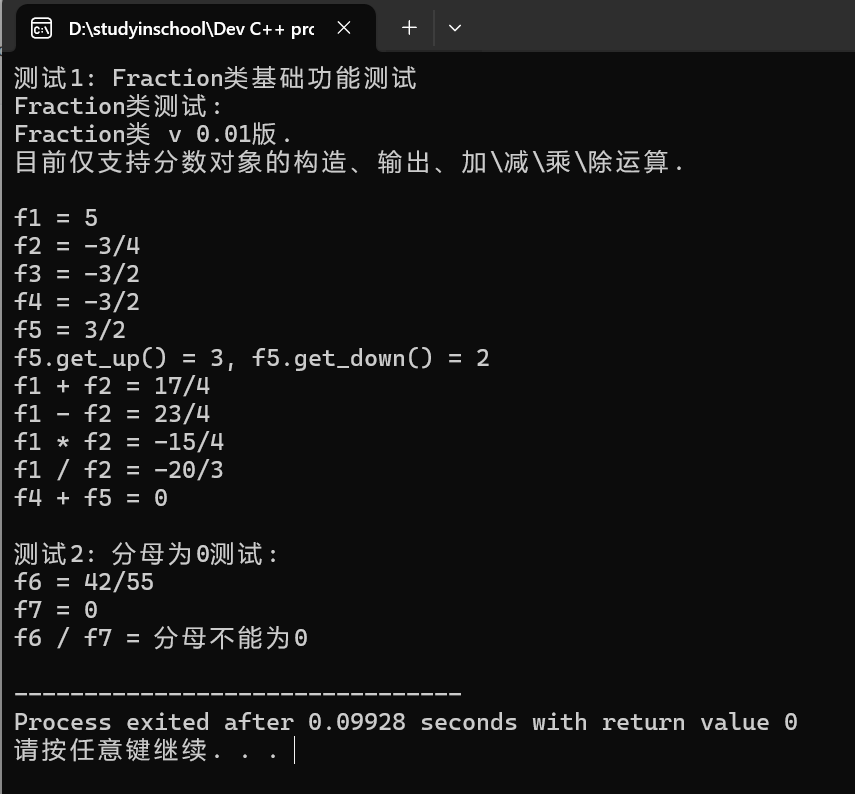实验二
任务一:
1.源代码:
(1)T.h:
#pragma once #include <string> // 类T: 声明 class T { // 对象属性、方法 public: T(int x = 0, int y = 0); // 普通构造函数 T(const T &t); // 复制构造函数 T(T &&t); // 移动构造函数 ~T(); // 析构函数 void adjust(int ratio); // 按系数成倍调整数据 void display() const; // 以(m1, m2)形式显示T类对象信息 private: int m1, m2; // 类属性、方法 public: static int get_cnt(); // 显示当前T类对象总数
public: static const std::string doc; // 类T的描述信息 static const int max_cnt; // 类T对象上限 private: static int cnt; // 当前T类对象数目 // 类T友元函数声明 friend void func(); }; // 普通函数声明 void func();
(2)T.cpp:
#include "T.h" #include <iostream> #include <string> // 类T实现 // static成员数据类外初始化 const std::string T::doc{"a simple class sample"}; const int T::max_cnt = 999; int T::cnt = 0; // 类方法 int T::get_cnt() { return cnt; } // 对象方法 T::T(int x, int y): m1{x}, m2{y} { ++cnt; std::cout << "T constructor called.\n"; } T::T(const T &t): m1{t.m1}, m2{t.m2} { ++cnt; std::cout << "T copy constructor called.\n"; } T::T(T &&t): m1{t.m1}, m2{t.m2} { ++cnt; std::cout << "T move constructor called.\n"; } T::~T() { --cnt; std::cout << "T destructor called.\n"; } void T::adjust(int ratio) { m1 *= ratio; m2 *= ratio; } void T::display() const { std::cout << "(" << m1 << ", " << m2 << ")" ; } // 普通函数实现 void func() { T t5(42); t5.m2 = 2049; std::cout << "t5 = "; t5.display(); std::cout << '\n'; std::cout << "func: T objects'current count: " << T::get_cnt() << std::endl; }
(3)task1.cpp:
#include "T.h" #include <iostream> void test_T(); int main() { std::cout << "test Class T: \n"; test_T(); std::cout << "\ntest friend func: \n"; func(); } void test_T() { using std::cout; using std::endl; cout << "T info: " << T::doc << endl; cout << "T objects'max count: " << T::max_cnt << endl; cout << "T objects'current count: " << T::get_cnt() << endl << endl; T t1; cout << "t1 = "; t1.display(); cout << endl; T t2(3, 4); cout << "t2 = "; t2.display(); cout << endl; T t3(t2); t3.adjust(2); cout << "t3 = "; t3.display(); cout << endl; T t4(std::move(t2)); cout << "t4 = "; t4.display(); cout << endl; cout << "test: T objects'current count: " << T::get_cnt() << endl; }
2.实验测试代码运行结果如下:

3.问题回答:
(1)YES;
(2)普通构造函数(line 9)是利用两个默认值为0的int类型的数据创建一个T类对象;复制构造函数(line 10)是将已有对象的属性拷贝到一个新的对象,相当于赋值操作;移动构造函数(line 11)是将该T类参数的所有资源等转移到新对象中,原对象变为空,类似剪切操作;析构函数(line 12)是将创建的对象销毁。至于调用时机,构造函数就看提供的参数是否对应上述函数参数类型,而析构函数在程序运行结束(释放内存空间)之前自动调用;
(3)YES,能够正常运行且结果不改变。
任务二:
1.源代码:
(1)Complex.h:
#pragma once #include <string> class Complex{ public: Complex(double a = 0,double b = 0); Complex(const Complex &c); ~Complex(); double get_real() const; double get_imag() const; void add(Complex c); private: double real,imag; friend void output(Complex c); friend double abs(Complex c); friend Complex add(Complex a,Complex b); friend bool is_equal(Complex a,Complex b); friend bool is_not_equal(Complex a,Complex b); public: static const std::string doc; };
(2)Complex.cpp:
#include "Complex.h" #include <iostream> #include <cmath> const std::string Complex::doc{"a simple class sample"}; Complex::Complex(double a,double b): real{a},imag{b}{} Complex::Complex(const Complex &c): real{c.real},imag{c.imag}{} Complex::~Complex(){ } double Complex::get_real() const{ return real; } double Complex::get_imag() const{ return imag; } void Complex::add(Complex c){ real += c.get_real(); imag += c.get_imag(); } void output(Complex c){ if(c.get_imag() >= 0) std::cout << c.get_real() << " + " << c.get_imag() << "i"; else std::cout << c.get_real() << " - " << (0-c.get_imag()) << "i"; } double abs(Complex c){ double abs = sqrt(c.get_real() * c.get_real() + c.get_imag() * c.get_imag()); return abs; } Complex add(Complex a,Complex b){ double c_r = a.get_real() + b.get_real(); double c_i = a.get_imag() + b.get_imag(); Complex c(c_r,c_i); return c; } bool is_equal(Complex a,Complex b){ if(a.get_real() == b.get_real() && a.get_imag() == b.get_imag()) return true; return false; } bool is_not_equal(Complex a,Complex b){ if(is_equal(a,b)) return false; return true; }
(3)task2.cpp:
// 待补足头文件 // xxx #include "Complex.h" #include <iostream> #include <iomanip> #include <complex> #include <string> void test_Complex(); void test_std_complex(); int main() { std::cout << "*******测试1: 自定义类Complex*******\n"; test_Complex(); std::cout << "\n*******测试2: 标准库模板类complex*******\n"; test_std_complex(); } void test_Complex() { using std::cout; using std::endl; using std::boolalpha; cout << "类成员测试: " << endl; cout << Complex::doc << endl << endl; cout << "Complex对象测试: " << endl; Complex c1; Complex c2(3, -4); Complex c3(c2); Complex c4 = c2; const Complex c5(3.5); cout << "c1 = "; output(c1); cout << endl; cout << "c2 = "; output(c2); cout << endl; cout << "c3 = "; output(c3); cout << endl; cout << "c4 = "; output(c4); cout << endl; cout << "c5.real = " << c5.get_real() << ", c5.imag = " << c5.get_imag() << endl << endl; cout << "复数运算测试: " << endl; cout << "abs(c2) = " << abs(c2) << endl; c1.add(c2); cout << "c1 += c2, c1 = "; output(c1); cout << endl; cout << boolalpha; cout << "c1 == c2 : " << is_equal(c1, c2) << endl; cout << "c1 != c2 : " << is_not_equal(c1, c2) << endl; c4 = add(c2, c3); cout << "c4 = c2 + c3, c4 = "; output(c4); cout << endl; } void test_std_complex() { using std::cout; using std::endl; using std::boolalpha; cout << "std::complex<double>对象测试: " << endl; std::complex<double> c1; std::complex<double> c2(3, -4); std::complex<double> c3(c2); std::complex<double> c4 = c2; const std::complex<double> c5(3.5); cout << "c1 = " << c1 << endl; cout << "c2 = " << c2 << endl; cout << "c3 = " << c3 << endl; cout << "c4 = " << c4 << endl; cout << "c5.real = " << c5.real() << ", c5.imag = " << c5.imag() << endl << endl; cout << "复数运算测试: " << endl; cout << "abs(c2) = " << abs(c2) << endl; c1 += c2; cout << "c1 += c2, c1 = " << c1 << endl; cout << boolalpha; cout << "c1 == c2 : " << (c1 == c2)<< endl; cout << "c1 != c2 : " << (c1 != c2) << endl; c4 = c2 + c3; cout << "c4 = c2 + c3, c4 = " << c4 << endl; }
2.实验代码运行结果如下:

3.问题回答:
问题一:
标准库模板类更简洁;函数能实现运算功能,但是不能直观的去表示运行,只能通过函数名来尽可能的理解功能,但是能够表达运算功能,但反观标准库,这样的表达更符合数学语言;
问题二:
(1)否。因为这些函数可以在public中也能实现。
(2)否。
(3)个人认为,当要多次访问私有属性时,可以使用友元,或者友元之间关系紧密时,可以使用;当一个功能可以通过公共接口实现,可以不用友元。
问题三:
可以通过在复制构造函数前加上explicit去实现。
任务三:
1.源代码:
(1)PlayerControl.h:
#pragma once #include <string> enum class ControlType {Play, Pause, Next, Prev, Stop, Unknown}; class PlayerControl { public: PlayerControl(); ControlType parse(const std::string& control_str); // 实现std::string --> ControlType转换 void execute(ControlType cmd) const; // 执行控制操作(以打印输出模拟) static int get_cnt(); private: static int total_cnt; };
(2)PlayerControl.cpp:
#include "PlayerControl.h" #include <iostream> #include <algorithm> int PlayerControl::total_cnt = 0; PlayerControl::PlayerControl() {} // 待补足 // 1. 将输入字符串转为小写,实现大小写不敏感 // 2. 匹配"play"/"pause"/"next"/"prev"/"stop"并返回对应枚举 // 3. 未匹配的字符串返回ControlType::Unknown // 4. 每次成功调用parse时递增total_cnt ControlType PlayerControl::parse(const std::string& control_str) { // xxx total_cnt++; std::string s = control_str; for(auto &a : s){ a = std::tolower(a); } if(s == "play") return ControlType::Play; else if(s == "pause") return ControlType::Play; else if(s == "next") return ControlType::Next; else if(s == "prev") return ControlType::Prev; else if(s == "stop") return ControlType::Stop; else return ControlType::Unknown; } void PlayerControl::execute(ControlType cmd) const { switch (cmd) { case ControlType::Play: std::cout << "[play] Playing music...\n"; break; case ControlType::Pause: std::cout << "[Pause] Music paused\n"; break; case ControlType::Next: std::cout << "[Next] Skipping to next track\n"; break; case ControlType::Prev: std::cout << "[Prev] Back to previous track\n"; break; case ControlType::Stop: std::cout << "[Stop] Music stopped\n"; break; default: std::cout << "[Error] unknown control\n"; break; } } int PlayerControl::get_cnt() { return total_cnt; }
(3)task3.cpp:
#include "PlayerControl.h" #include <iostream> void test() { PlayerControl controller; std::string control_str; std::cout << "Enter Control: (play/pause/next/prev/stop/quit):\n"; while(std::cin >> control_str) { if(control_str == "quit") break; ControlType cmd = controller.parse(control_str); controller.execute(cmd); std::cout << "Current Player control: " << PlayerControl::get_cnt() << "\n\n"; } } int main() { test(); }
2.实验代码运行结果如下:

任务四:
1.源代码:
(1)Fraction.h:
#pragma once #include <string> int find_max(int a,int b); class Fraction{ public: Fraction(int u,int d = 1); Fraction(const Fraction &f); ~Fraction(); int get_up() const; int get_down() const; Fraction negative() const; static const std::string doc; private: int up,down; friend void output(Fraction f); friend Fraction add(Fraction a,Fraction b); friend Fraction sub(Fraction a,Fraction b); friend Fraction mul(Fraction a,Fraction b); friend Fraction div(Fraction a,Fraction b); };
(2)Fraction.cpp:
#include "Fraction.h" #include <string> #include <iostream> Fraction::Fraction(int u,int d ){ int a ; a = find_max(u,d); up = u / a; down = d / a; } Fraction::Fraction(const Fraction &f): up{f.up},down{f.down}{} Fraction::~Fraction(){ } const std::string Fraction::doc{"Fraction类 v 0.01版.\n目前仅支持分数对象的构造、输出、加\\减\\乘\\除运算."}; int Fraction::get_up() const{ return up; } int Fraction::get_down() const{ return down; } Fraction Fraction::negative() const{ return Fraction(-up,down); } void output(Fraction f){ if(f.down == 0){ std::cout << "分母不能为0"; return; } if(f.up % f.down == 0){ std::cout << f.up/f.down; return; } if(f.down < 0){ std::cout << -f.up << "/" << -f.down; }else{ std::cout << f.up << "/" << f.down; } } Fraction add(Fraction a,Fraction b){ int down1 = a.down * b.down; int up1 = a.up * b.down + b.up * a.down; return Fraction(up1,down1); } Fraction sub(Fraction a,Fraction b){ int down1 = a.down * b.down; int up1 = a.up * b.down - b.up * a.down; return Fraction(up1,down1); } Fraction mul(Fraction a,Fraction b){ int down1 = a.down * b.down; int up1 = a.up *b.up; return Fraction(up1,down1); } Fraction div(Fraction a,Fraction b){ int down1 = a.down * b.up; int up1 = a.up *b.down; return Fraction(up1,down1); } int find_max(int a,int b){ while(b != 0){ int temp = b; b = a % b; a = temp; } return a; }
(3)task4.cpp:
#include "Fraction.h" #include <iostream> void test1(); void test2(); int main() { std::cout << "测试1: Fraction类基础功能测试\n"; test1(); std::cout << "\n测试2: 分母为0测试: \n"; test2(); } void test1() { using std::cout; using std::endl; cout << "Fraction类测试: " << endl; cout << Fraction::doc << endl << endl; Fraction f1(5); Fraction f2(3, -4), f3(-18, 12); Fraction f4(f3); cout << "f1 = "; output(f1); cout << endl; cout << "f2 = "; output(f2); cout << endl; cout << "f3 = "; output(f3); cout << endl; cout << "f4 = "; output(f4); cout << endl; const Fraction f5(f4.negative()); cout << "f5 = "; output(f5); cout << endl; cout << "f5.get_up() = " << f5.get_up() << ", f5.get_down() = " << f5.get_down() << endl; cout << "f1 + f2 = "; output(add(f1, f2)); cout << endl; cout << "f1 - f2 = "; output(sub(f1, f2)); cout << endl; cout << "f1 * f2 = "; output(mul(f1, f2)); cout << endl; cout << "f1 / f2 = "; output(div(f1, f2)); cout << endl; cout << "f4 + f5 = "; output(add(f4, f5)); cout << endl; } void test2() { using std::cout; using std::endl; Fraction f6(42, 55), f7(0, 3); cout << "f6 = "; output(f6); cout << endl; cout << "f7 = "; output(f7); cout << endl; cout << "f6 / f7 = "; output(div(f6, f7)); cout << endl; }
2.实验代码运行结果如下:

3.问题回答:
我选择了友元方案。因为这些计算是基本上都是同一类对象之间的运算,而且基本只用到了内部的私有属性,更加方便书写代码以及逻辑,以达到提高性能的作用;但这样却提高了耦合度,如果友元出错,则需要更改部分较多代码,可维护性较差,但是介于项目逻辑简单且代码数量较少,可以选择此方法。
实验总结:
对于类对象功能的实现,有许多办法,需要合理利用这些方法的优缺点根据实际情况去选择,以优化代码,提高代码可读性,并且便于后期维护。




 浙公网安备 33010602011771号
浙公网安备 33010602011771号